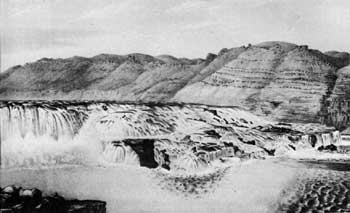






Historical Background
| June 11-16 1805 |
A majestic view: the Great Falls
If the right decision had been made, according to the Minitaris the Great Falls could not be far distant. Anxious to find out, on June 11—after the expedition had spent 9 days at the Marias—Lewis, Drouillard, Joseph Field, Gibson, and Goodrich set out from its mouth via land to make maximum speed. Clark and the main party followed the next day with all the boats except the red pirogue. It had been hidden on an island at the mouth of the Marias, where equipment and supplies had also been cached along the riverbank.
The Lewis group pushed westward across the mountain-defined plains. Before noon the second day, a tremendous roar was heard and in the distance spray could be seen rising like a column of smoke. The elated Lewis knew he had arrived at the falls, the true beginning of the Rocky Mountains. That day and the next, the 13th and 14th, he and his companions reconnoitered the falls all the way to the Sun River. Within a stretch of 10 miles, the Missouri dropped 400 feet, foaming over five cascade-like falls and a series of rapids. Lewis estimated the height of the highest of these falls, the one farthest downstream, at 87 feet.
Realizing that Clark was anxious to know whether or not the correct decision had been made at the Marias, at sunrise on the 14th Lewis sent Joseph Field back to tell him they had found the falls and to proceed only to their lower end, where the portage would begin, and wait there. The timber available, rare in the area, made it an especially desirable campsite.
On the 14th, while waiting for the main party and investigating the portage area, Lewis had his fill of adventure. Alone and dreamily contemplating a buffalo he had just shot, his rifle not reloaded, to his shock he suddenly saw a grizzly only 20 paces away lumbering toward him. Lewis attempted to avoid a charge by walking nonchalantly away. But the animal charged at full speed. Lewis bolted for the river, 80 yards away. Dashing into the water up to his waist, he suddenly whipped around and pointed his espontoon at the beast. For some strange reason, it stopped, turned, ran pellmell back across the prairie, and disappeared into some woods.
A short time later, Lewis suddenly saw a brownish-yellow, feline-like animal he could not identify about to pounce on him. His gun loaded this time, he fired but the beast disappeared into a burrow. The relieved Lewis rejoined his companions. The next morning, upon waking, he shot a large rattlesnake, coiled up about 10 feet away on the leaning trunk of the tree he had been sleeping under, and found it had 17 rattles. By this time, rattlers had become a serious threat and several men had experienced close calls with them.
Clark and the main party, which had been slowed by rapid currents and dangerous rocks, arrived at the lower end of the falls on the evening of June 15. They camped on the south, or east, bank of the river about a mile north, or below, of what they called "Portage Creek" (modern Belt Creek) at a spot that came to be known as "lower portage camp." The next afternoon, they reunited with Lewis detachment.
 |
| Great Falls of the Missouri in 1867, from the south bank of the river. Lewis reached the falls on June 13, 1805. He had heard the roar of the water from a distance of 7 miles away. (Lithograph and pencil sketch by A. E. Mathews, in his privately published Pencil Sketches of Montana (New York, 1868), Plate XXIV.) |
Illness of Sacagawea
Everyone was concerned about Sacagawea, who had been seriously ill for a week. Clark had bled her, applied poultices to her abdomen, and ministered all kinds of purges and other medicines. Feverish, she had a weak pulse and seemed near death, but neither of the captains could correctly diagnose her condition. Fortunately, water brought from a sulphur spring someone had discovered across the river proved to have a beneficial effect and she recovered in a few days.
The sulphur water saved the life of the Indian girl, but no such panacea was available for the staggering job of portaging around the Great Falls.
 |
http://www.cr.nps.gov/history/online_books/lewisandclark/intro36.htm
Last Updated: 22-Feb-2004